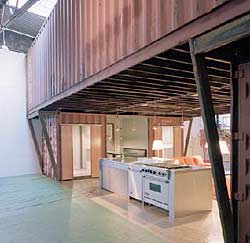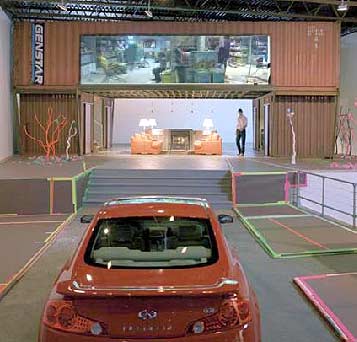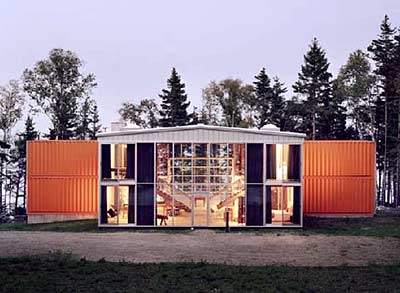Containing a Home: Adam Kalkin '84
For many homeowners, discovering the history behind their houses holds special interest. For those whom architect Adam Kalkin ’84 helps become homeowners, however, learning their houses’ stories isn’t about asking traditional questions, like “When was it built?” or “Who lived here?” Instead it requires asking, “Where in the world has my house been?” Literally.
Perhaps traditional questions can’t reveal these structures’ histories because Kalkin’s new domestic design, Quik House, is anything but traditional. Fairly ordinary when first described—three bedrooms, two and a half baths, 2,000 square feet, with options such as a stainless steel kitchen outfit, mahogany doors, and custom-designed carpets—it is Quik House’s shell that surprises most: five recycled, steel shipping containers, stacked in building-block fashion (three on top, two on the bottom), give the house its shape. Add in the ability to purchase the home, available in either orange or natural “rust bloom,” from Kalkin’s Website and a less-than-five-month wait from order to move-in—all starting at $76,000 plus shipping—and the result is a truly innovative approach to domestic architecture.
The idea to do something with shipping containers came to Kalkin, a New Jersey resident, through frequent drives to New York City, where he saw sky-high stacks of the unused cargo containers in the shipyards he passed. Only after his personal reaction to the containers as appealing objects—he remarks that they have “interesting structural and spatial properties”—did he begin to consider their domestic possibilities, an outcome typical of his creative process. “You get moments where the logic you are using is much more personal and less full of intention—and not so much within the conscious part of the mind,” he says.

The cargo containers, with a life span of about 20 years when used for their original purpose, have an “infinite life span” when stationary and properly maintained, Kalkin says. Giving these formerly mobile containers a permanent home as homes means that despite providing the structure for a brand-new house, each container comes with its own ready-made and traveled history. “You can look at them both as junk or as something special,” Kalkin notes. “To me they are like a treasured antique: they may not be inherently valuable, but the history and the storytelling add value.” Kalkin’s inventive architectural vision grows directly out of his belief in interconnectedness. He argues, “We come from a culture of sampling. I’m just out there in the world picking out things and reusing things—sampling—from my experience and from what other people have already invested a lot of time and energy in. I think there’s a tremendous amount of richness out there.”
His ability to mix unlikely sources and materials with the fairly straightforward domain of domestic architecture sets him apart from other architects, he thinks: “I’m a little bit outside of architecture, in the sense of my lack of allegiance to a specific kind of behavior or orthodoxy. I don’t value architecture culture over other cultures: I draw from writers, music, and the visual arts. Who wants to narrow the world down?” Instead Kalkin hopes he’s “seeing real connections between things and reaching toward a humanitarian core,” revealing that the “distinctions we’ve built up are false ones.” Just as insects make the most of a fallen tree in a forest, utilizing the tree for both shelter and food, Kalkin sees the sense in “repurposing” objects for architectural ends. Or, as he says, “Any kind of junk can be turned into stuff.”
Because of their affordability and the relative speed in which Quik Houses can be built, it’s not surprising that they’ve been claimed as an obvious answer for emergency or temporary housing needs. In fact, Kalkin & Co. have developed a Quik Build Disaster Relief Swat Team, a team of architects, energy and water experts, agronomists, and builders who are available to provide emergency housing around the world. Environmentalists as well have embraced the design, applauding the recycling inherent to Kalkin’s new builds. And advocates for affordable-housing options like the design, since the total cost of a house—between $150,000 and $175,000 after the buyer settles upon the various options—works out to be between $73 and $90 per square foot, about half the cost of the conventional $200 per square foot for “reasonable quality, new construction in the Northeast.”

View from driveway of “Suburban House Kit”
While Kalkin admits that once he designs something and releases it into the world he doesn’t mind who takes up the design or what exactly they do with it, he does resist associations between his purpose and specific causes. “Sometimes there’s a natural alliance between me and the environmentalist world. However, whenever you get orthodox about something, you lose your conceptual playfulness. You then have a framework, and, ultimately, you become boring. There is a humanitarian core to what I’m doing, but I also don’t want to feel like I’m too serious and totally in service to other people.”
Kalkin is working with Natalia Vodianova (Russian model recently featured on the cover of Vanity Fair) and the Naked Heart Foundation to build 200 playhouses for poor children across Russia, with the U.S. Army in Kabul, and with professionals in the energy field, helping to create factories and laboratories for the testing of new kinds of fuel. He admits he is perhaps less interested in helping someone from our “ultra-evolved consumer culture build a less expensive house on Long Island.” Nonetheless, he says, “I don’t differentiate between art, commerce, performance, books, houses, humanitarian, bourgeois, high, or low. It’s all a creative continuum, and the connections can be very stimulating. The main idea is make a mess, change the world, and have fun.”
Because Kalkin doesn’t want the Quik House to become pigeonholed into a particular purpose, he strives for a “conjunctive aspect” in his work. He says: “What I really like is saying, ‘I want to do this and this,’ not either/or or this/not that. I like work that won’t root itself in one particular design, where all the buttons are being pressed at once. You’re really changing the world then.”
Kalkin has recently made the important decision of maintaining control over his house. Left with the choice either to license his designs or begin to manufacture the products himself, he’s opened a factory—“a hangar at a little airport in New Jersey”—to do just that. “I need to own the product,” he says. “There are a lot of elbows flying in this process, and this is the best way to protect the quality of the house, to keep the accounting transparent, and to make sure I am not unwittingly responsible for heinous crimes to the built environment.” Once the factory is fully functional, Kalkin plans to export many of his products, commenting that “the possibilities of working on a world scale are exciting.”
Despite aspiring to reach a global market, Kalkin has recently focused close to home, working with his own high school, the Pingry School in New Jersey. In cooperation with the school, he applied for and was awarded a $10,000 grant from the U.S. Trust Company to fund interdisciplinary research, development, and construction of a disaster-relief housing prototype on the Martinsville campus of the Pingry School.

Twelve-container house (Adriance House), Blue Hill, Maine, 2003
In addition to helping modify and build the structures, students will explore the economic, agricultural, energy, and health issues that often accompany disasters, natural or otherwise, and necessitate emergency housing—including working with soil scientists and agronomists to suggest plants and vegetables best suited for particular geographic locales and climates to go with the housing.
Kalkin hopes that the project will not only help students learn about building design, structural engineering, and bio-intensive farming techniques, but also “provide a generic model from which many villages can be created and intelligently adapted to local culture.” Institutions such as Pingry have a specific responsibility in this kind of research, Kalkin feels. “Since architecture is a capital-intensive and profit-oriented affair, very little talent and few resources have been directed at housing solutions for the poorest stratum of the world population. It is incumbent on public-oriented institutions like Pingry to address proactively issues that will never naturally attract the capital markets of business and ideas.” He adds, “This project will benefit the student community at Pingry, but more importantly it will contribute to the discourse surrounding the issue of adequate housing throughout the world.”
Kalkin admits that he’s interested in doing something at Vassar as well— either a temporary structure or sculpture or working with students—since he considers it one of the only “institutions [he’s] ever had anything to do with that [he] thought was in any way cool.” He remembers great teachers who engaged him, despite his being “somewhat of a difficult student.” To this end, Kalkin visited campus on two occasions this spring as a special guest in Assistant Professor of Art Barry Price’s architecture courses at the college. Price invited Kalkin to be a guest teacher and critic because, as Price puts it, he “thought Kalkin would be interesting, not only for the range of his architectural work, but for the multidisciplinary approach that he brings to his practice. This is a great model for the liberal arts-based students” at Vassar.
Price said he chose to collaborate with Kalkin—who first visited in April to help frame and devise an architectural design problem for the students and subsequently returned in May to play the role of “client” in a critique of the students’ final work—because he is “much more interested in architects who are the exception, rather than those who maintain the more conventional approach to the profession.”
Photo credit: Peter Aaron
To learn more about Quik House, visit www.architectureandhygiene.com.
